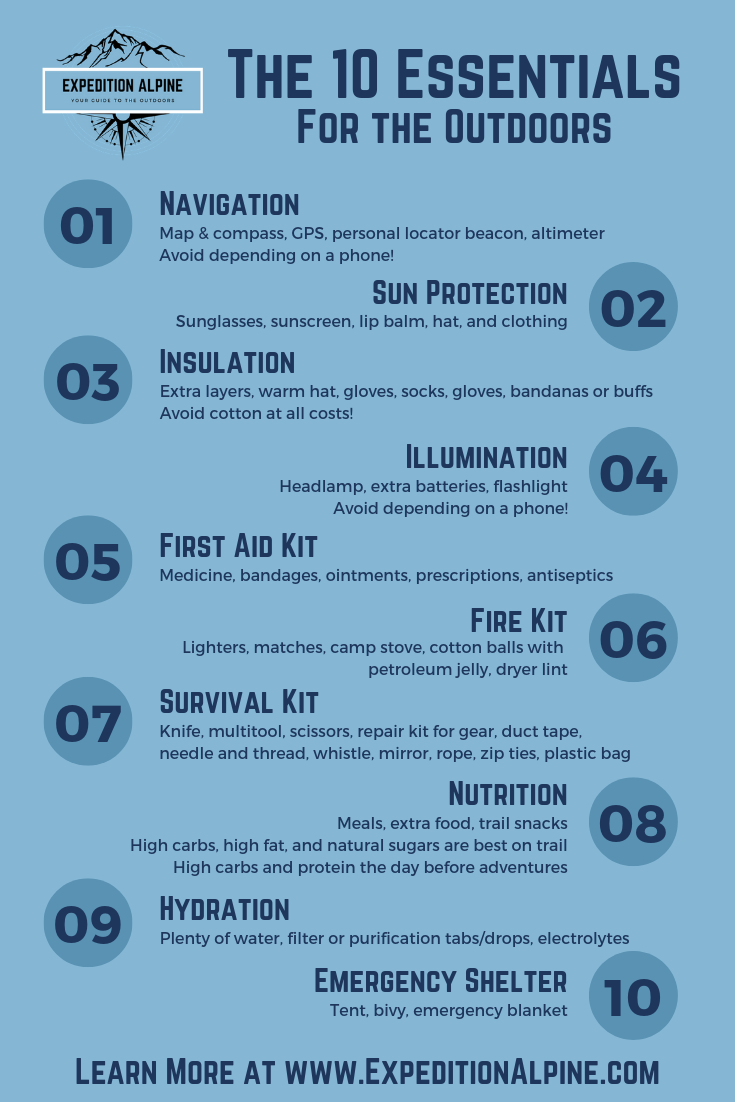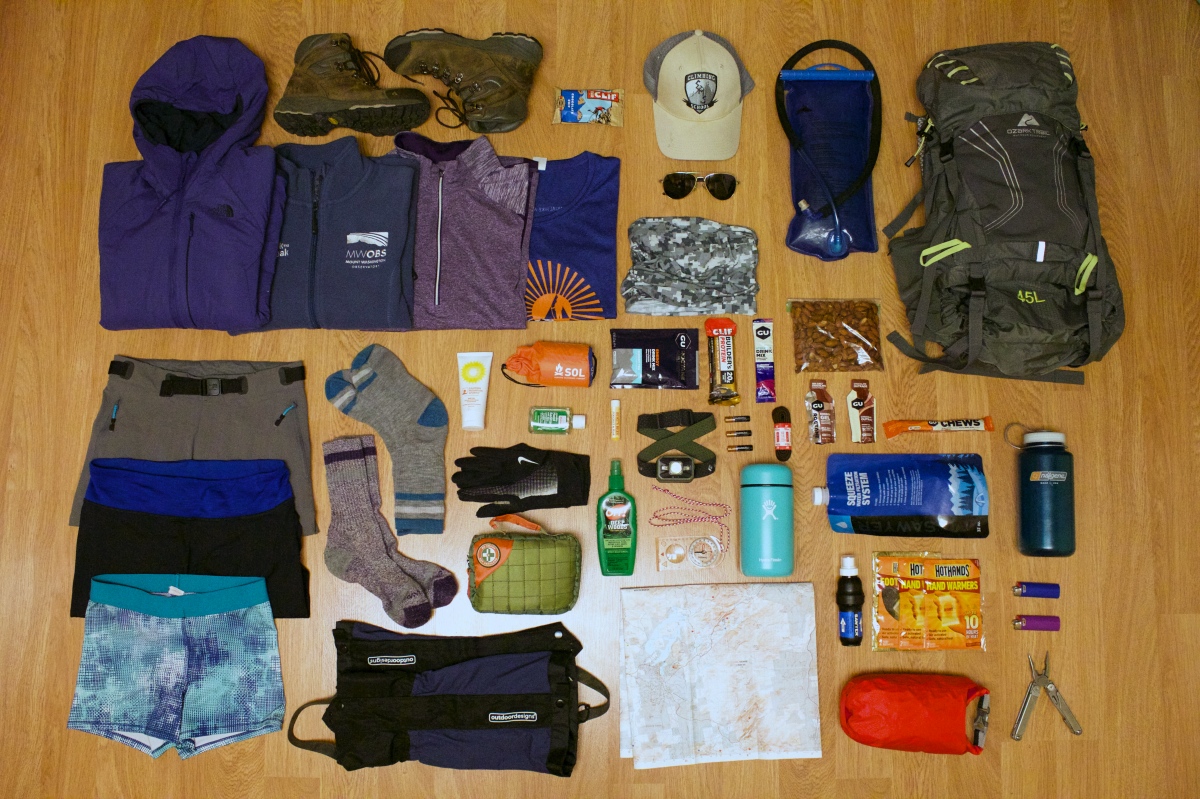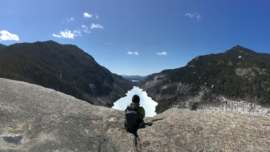A Little History…
The “Ten Essentials” is a list of items that are recommended to be carried by everyone going into the backcountry. This list can be used for any sport, whether you’re hiking, kayaking, rock climbing, or more. The Ten E
While list has changed a little over the years as gear has advanced and become more complex, the overall approach has remained the same. Mainly, it has changed from an items approach to a systems approach.
Why Bother?
The Ten Essentials are crucial to
The 10 Essentials

Navigation –
You should always carry a map and compass! “But I have an app on my phone!” Well, unfortunately, it’s very easy to break your phone on a hike. You can drop it on rocks, it could go for a swim, or could just give out on you entirely. Batteries drain very quickly in cold weather. Even a cool spring or fall day can kill your phone in a couple of hours. Many hikers have been rescued because they were navigating using a phone, only to learn the hard way that it’s not always reliable! A compass is always the best option.
Equally important, know how to use it, and practice often. Without that knowledge, all a compass can do for you is point North… Use a compass at summits to name the mountains around you! It’s good practice to keep your skills refreshed, and saves you from having to carry those peak finder booklets.
Other optional navigation items are Global Positioning System devices (GPS), Altimeters, or Personal Locator Beacons (PLB). GPS devices will show your location and track your route, just like a better version of that app on your phone. Altimeters show your elevation above sea
Sun Protection –
This is important year-round! You can easily sunburn from the reflection off of water or snow. Some good items to carry are sunglasses, sunscreen, lip balm, a hat, and clothing. Buy a lightweight long sleeve shirt, it can prevent a lot of pain later!
As far as sunscreen goes, look for one that blocks both UVA and UVB rays. Use SPF 30 for general activities and SPF 50 when the sun can reflect, like in winter or when you are out on the water. If you are concerned about the effects of your sunscreen on the environment, purchase a reef-safe version. Look for one without oxybenzone or
For sunglasses, polarized ones are great! They will greatly reduce glare when you are out in the intense sun or on the water. The downside is it typically makes it harder to see the screens on electronic devices.
Insulation –
You should prepare for the hottest or coldest weather possible for the season you are in. In winter, that means a hat, gloves, extra socks, and more layers. Bring duplicates of anything that can easily get wet. If you slipped into water, or if there was an emergency that required you to be stationary for a long period of time, you need to have the layers to provide you warmth.
In summer, pack layers that allow you to protect from the sun, and to vent extra body heat. Bandanas or buffs can protect you from the sun or dust, and help wipe away sweat. They can also be soaked and wrapped on your head to help you cool down.
Moisture-wicking items are important year round. Water- or sweat-logged clothes can easily cause hypothermia in the
Illumination –
You should always carry a light source, even on short day trips! Accidents can happen, and you can end up staying out longer than intended. A flashlight or headlamp can help you see your map and the trail while you make your way back to the car. Again, don’t trust your phone. There are just too many ways it can break or stop working. If you’re having issues with the batteries of your headlamp draining in your pack, carry an extra set, or flip the batteries around backwards. LED lights also use less power.
It is also recommended to spend the money and buy a nicer headlamp or flashlight. Sometimes you can get lucky, but most of the cheapy Amazon or Walmart headlamps do not compare to name brand headlamps of equal lumens (please take this from my personal experience!).
First Aid Kit –
This is one of those items that is better to have and never need, than to need and not have. You can build one from scratch, or buy a pre-made one and customize it to your needs. Some important things to have are a variety of bandages and gauzes, medicine (for pain relief, allergies, and electrolyte tabs), a tick remover, and sanitary wipes or hand sanitizer. It is also advised to carry insect repellant and foot care items.
Customize your kit to your needs. Carry an epi-pen, personal medication, and other items based on common issues you may face. It’s also a good idea to carry real Asprin, in case you or someone you meet develops heart attack symptoms. You can crush the Asprin and put it under their tongue, which helps it absorb faster. This can buy you precious time in the event of an emergency. For diabetics, or anyone who’s blood sugar may have dipped from over-exertion, pieces of drinking straws filled with honey can be very useful. You can pinch the ends of the straw with pliers and melt it shut with a lighter. Honey doesn’t spoil so it is safe for long term storage.
Fire Kit –
It’s always good to have two sources of fire on you, whether you chose lighters, matches, a stove, cotton balls soaked in petroleum jelly, or flammable gel. It’s easy to lose one of your sources, or have it not work. Fire can help keep you warm, signal to others or for help, and camp smoke can help keep bugs away.
Survival Kit/Repair Kit & Tools –
This can also be customized to your needs! Carry a knife, a multitool, scissors, pliers, a screwdriver, trowel, duct tape, zip ties, extra buckles, cordage or rope, a whistle or mirror for signaling, a trash bag, needle and thread, and more! You should have items in here to make your life easier in a survival situation and to be able to fix your gear if it were to break in the backcountry. Don’t be afraid to carry extra parts for critical items like traction devices, water filters, stoves, and tents.
Shopping bags or bread bags can double as a waterproof barrier for your socks, or can be used to pack out your garbage. A multitool may seem a bit overboard until your glasses get crushed and you need to bend them back into shape and screw the arm back together with an itty-bitty screwdriver. Straps on packs, snowshoes, crampons, and microspikes can break, and sometimes are rendered useless without being able to fix it.
Nutrition –
Fueling your body is incredibly important. It helps keep your body temperature up, preventing hypothermia. Having improper nutrition can also cause you to run low on electrolytes, which can become dangerous. Make sure you eat well the day before a big trip, and eat breakfast the day of. Refuel often on the trail with granola bars, candy bars, trail mix, jerky, or whatever else you enjoy. It’s also a good idea to have electrolyte tabs or some sort of sports drink on longer outings.
Hydration –
Hydration is just as important as nutrition. The effects of dehydration can also be debilitating. It’s easy to become dehydrated without noticing it too. If you feel thirsty, you’re already behind. You should be drinking regularly on the trail, and more so if you sweat a lot. You need just as much water in the winter as in the summer. While a lot of water is lost through sweat, you lose a lot through respiration as well. The moisture in your breath is lost to the air in the winter, and can also cause you to become dehydrated.
Emergency Shelter –
This can be as extreme as a tent, or as simple as an emergency blanket or bivy. Most outdoor retailers carry very small bivies for fairly cheap. As with the rest of the Ten Essentials, you should always carry it with you. In an emergency, it’s no use to you if it’s back at camp or if you dropped pack at an intersection somewhere.
Change It Up
What you choose to carry for the Ten Essentials should change depending on your gear and the season. Don’t be afraid to try new things, as long as you have some form of each of the essentials. There’s also the rule of redundancy – pack extras of each – in case the first one gets lost, blown away, or breaks.
Take the length of the trip into account as well. What you take on a two-mile hike, should not be the same as what you take on a long-term backpacking or paddling trip. A PLB and tent is overkill for the former, but may be necessary for the latter. You probably don’t need to carry pocket warmers during summer heat.
Check what you carry often, not only to get rid of what’s unnecessary, but also to be familiar with where you put it. In an emergency, all the pockets in a first aid kit look the same. Don’t hesitate to label stuff that seems obvious, as it can save you some fumbling around when the seconds count. Regularly check all expiration dates on the items in your first aid kit as well.
Is there anything unique that you like to carry with your Ten Essentials? Let me know in the comments below!


